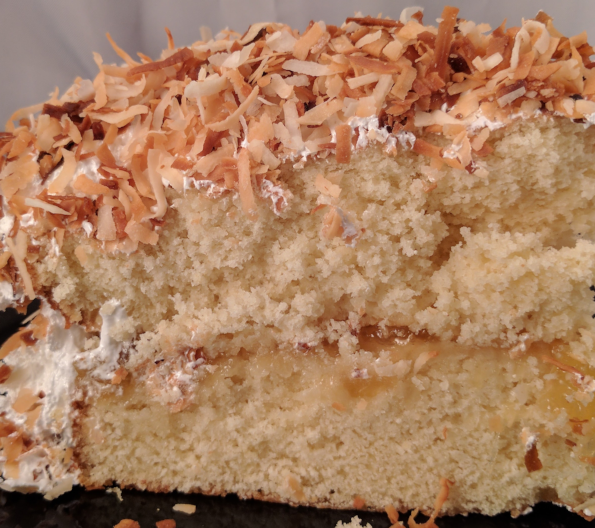Here are all of the flavors of a piña colada in a light and fluffy cake. Unlike many rum cakes, the liquor in this cake isn’t overpowering.

- 3 cups (360 grams) bleached all-purpose flour, sifted
- 1 Tablespoon baking powder
- 1 teaspoon kosher salt (or .5 teaspoon table salt)
- 8 ounces (by weight) unrefined coconut oil, melted
- 4 large eggs, at room temperature
- 1 teaspoon vanilla
- .5 cup pineapple juice, at room temperature
- .5 cup coconut milk, at room temperature
- 2 cups minimally-processed sugar
- 4 Tablespoons white rum, divided
Heat your oven to 350 degrees Fahrenheit. Grease or spray two 9”x3” round baking pans, place parchment rounds in the bottom of the pans and grease or spray the parchment. Set aside.
Fit your mixer with the paddle attachment. Combine the sifted flour, baking powder and salt in the mixer’s bowl. Turn the mixer on at its lowest setting and allow the ingredients to mix for 3 minutes.
Add the melted coconut oil and allow it to combine with the flour on the mixer’s lowest setting. Continue until the oil has coated all of the flour. Add the eggs, one at a time, mixing throughly after each addition.
Combine the vanilla, pineapple juice and coconut milk in a container and mix. Alternate adding this liquid and the sugar into the bowl, in thirds, mixing thoroughly after each addition.
Turn the mixer up to medium speed and beat the batter for three minutes. Divide the batter evenly between the prepared pans. Bake for approximately 26-28 minutes, until a toothpick inserted in the center of the cake comes out clean.
Cool in the pan on a wire rack for 10 minutes. Remove the layers from the pan, and the parchment from the bottoms, and cool (tops up) to room temperature on a wire rack.
When the layers are cool, use a fork to poke holes in the tops of each layer. Carefully pour 2 tablespoons of the rum into the small holes of one layer, pouring slowly to allow the rum to sink evenly into the layer. Repeat with another 2 tablespoons of rum on the other layer.
Fill the cake
- 12 ounce jar of pineapple preserves
Carefully move one layer to your serving plate, top up. Spread all of the preserves over the top of the layer. Do not spread the preserves all the way to the edge of the layer as the preserves will spread when you top the cake with the other layer. Carefully place the other layer, top down, on this layer.
Frost the cake
- 14 ounce bag of sweetened, flaked coconut
- 1 cup white sugar
- 1/2 cup water
- 4 whites of large eggs, at room temperature
- 1/2 teaspoon cream of tartar
- 2 teaspoons kirsch
- 2 Tablespoons white rum
Heat the oven to 325 degrees Fahrenheit. Spread the coconut evenly over a baking sheet and put the coconut in the oven. Every few minutes, use a fork to rearrange the coconut on the tray. Continue doing this until the coconut is toasted: tan to light brown, but not burned. Remove from oven and set aside to cool.
In a small saucepan, combine the sugar and water and fit the saucepan with a candy thermometer. Place on the stove, but do not begin heating yet.
Using a stand mixer fitted with the whisk attachment, whip the egg whites on medium-high speed until foamy. Add the cream of tartar and whip on medium-high speed until sturdy peaks form. Turn the mixer off.
Turn the heat under the saucepan to medium-high. Cook the mixture until it reaches 240 degrees Fahrenheit. Turn the mixer to high and slowly incorporated the sugar syrup in a thin stream into the egg whites, being careful not to get any on the whisk. If you cannot do this, you can alternate turning the mixer off, pouring in a small amount of the sugar syrup, then turning the mixer up to high to incorporate completely and repeating the process until all of the sugar syrup is incorporated. Leave the mixer on high, and continue to whip until the outside of the bowl is warm, but not hot to the touch. Add the kirsch and continue whipping a few minutes longer, until close to room temperature.
Using a pastry brush, coat the outside of the cake with the two tablespoons of rum. Cut small strips of paper or foil and slip them under the sides of the cake, to prevent any icing from getting on your serving plate. Then evenly cover the top and sides with the icing, using all of the icing. Coat the outside of the cake with the toasted coconut. You will need to be careful doing this on the sides. One way is to gently tip the cake while pushing handfuls of the coconut into the icing. The icing is very sticky and will hold the coconut. (You might want to use a latex glove to minimize the mess.) Remove the strips protecting the cake plate.
Store in the refrigerator, but bring slices to room temperature before serving.